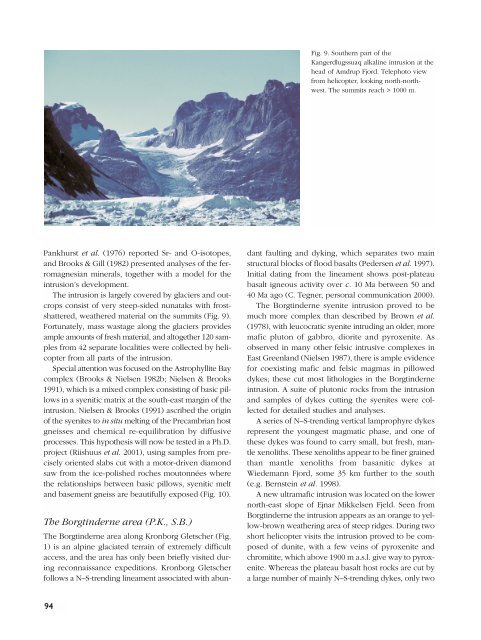The Nalunaq gold prospect, South Greenland - Geus
The Nalunaq gold prospect, South Greenland - Geus
The Nalunaq gold prospect, South Greenland - Geus
Create successful ePaper yourself
Turn your PDF publications into a flip-book with our unique Google optimized e-Paper software.
Fig. 9. <strong>South</strong>ern part of the<br />
Kangerdlugssuaq alkaline intrusion at the<br />
head of Amdrup Fjord. Telephoto view<br />
from helicopter, looking north-northwest.<br />
<strong>The</strong> summits reach > 1000 m.<br />
Pankhurst et al. (1976) reported Sr- and O-isotopes,<br />
and Brooks & Gill (1982) presented analyses of the ferromagnesian<br />
minerals, together with a model for the<br />
intrusion’s development.<br />
<strong>The</strong> intrusion is largely covered by glaciers and outcrops<br />
consist of very steep-sided nunataks with frostshattered,<br />
weathered material on the summits (Fig. 9).<br />
Fortunately, mass wastage along the glaciers provides<br />
ample amounts of fresh material, and altogether 120 samples<br />
from 42 separate localities were collected by helicopter<br />
from all parts of the intrusion.<br />
Special attention was focused on the Astrophyllite Bay<br />
complex (Brooks & Nielsen 1982b; Nielsen & Brooks<br />
1991), which is a mixed complex consisting of basic pillows<br />
in a syenitic matrix at the south-east margin of the<br />
intrusion. Nielsen & Brooks (1991) ascribed the origin<br />
of the syenites to in situ melting of the Precambrian host<br />
gneisses and chemical re-equilibration by diffusive<br />
processes. This hypothesis will now be tested in a Ph.D.<br />
project (Riishuus et al. 2001), using samples from precisely<br />
oriented slabs cut with a motor-driven diamond<br />
saw from the ice-polished roches moutonnées where<br />
the relationships between basic pillows, syenitic melt<br />
and basement gneiss are beautifully exposed (Fig. 10).<br />
<strong>The</strong> Borgtinderne area (P.K., S.B.)<br />
<strong>The</strong> Borgtinderne area along Kronborg Gletscher (Fig.<br />
1) is an alpine glaciated terrain of extremely difficult<br />
access, and the area has only been briefly visited during<br />
reconnaissance expeditions. Kronborg Gletscher<br />
follows a N–S-trending lineament associated with abundant<br />
faulting and dyking, which separates two main<br />
structural blocks of flood basalts (Pedersen et al. 1997).<br />
Initial dating from the lineament shows post-plateau<br />
basalt igneous activity over c. 10 Ma between 50 and<br />
40 Ma ago (C. Tegner, personal communication 2000).<br />
<strong>The</strong> Borgtinderne syenite intrusion proved to be<br />
much more complex than described by Brown et al.<br />
(1978), with leucocratic syenite intruding an older, more<br />
mafic pluton of gabbro, diorite and pyroxenite. As<br />
observed in many other felsic intrusive complexes in<br />
East <strong>Greenland</strong> (Nielsen 1987), there is ample evidence<br />
for coexisting mafic and felsic magmas in pillowed<br />
dykes; these cut most lithologies in the Borgtinderne<br />
intrusion. A suite of plutonic rocks from the intrusion<br />
and samples of dykes cutting the syenites were collected<br />
for detailed studies and analyses.<br />
A series of N–S-trending vertical lamprophyre dykes<br />
represent the youngest magmatic phase, and one of<br />
these dykes was found to carry small, but fresh, mantle<br />
xenoliths. <strong>The</strong>se xenoliths appear to be finer grained<br />
than mantle xenoliths from basanitic dykes at<br />
Wiedemann Fjord, some 35 km further to the south<br />
(e.g. Bernstein et al. 1998).<br />
A new ultramafic intrusion was located on the lower<br />
north-east slope of Ejnar Mikkelsen Fjeld. Seen from<br />
Borgtinderne the intrusion appears as an orange to yellow-brown<br />
weathering area of steep ridges. During two<br />
short helicopter visits the intrusion proved to be composed<br />
of dunite, with a few veins of pyroxenite and<br />
chromitite, which above 1900 m a.s.l. give way to pyroxenite.<br />
Whereas the plateau basalt host rocks are cut by<br />
a large number of mainly N–S-trending dykes, only two<br />
94

















